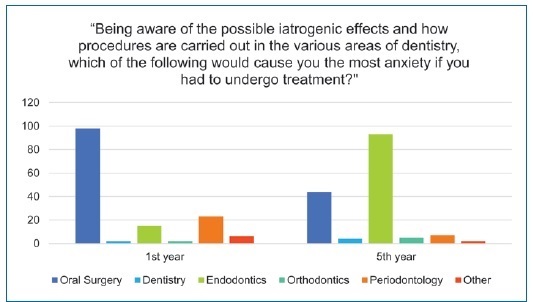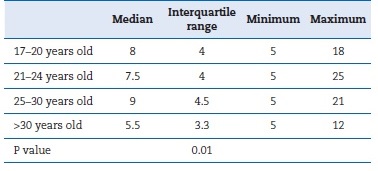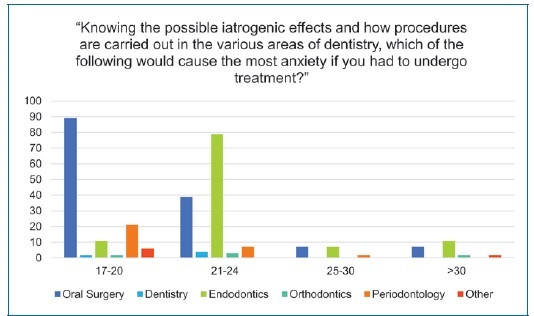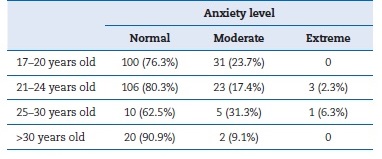Introduction
Anxiety is a normal reaction to stress that can be beneficial in alerting and preparing the individual for certain situations.1 It is associated with muscle tension and the behavior of avoiding a situation that has not yet happened.2 Fear, on the other hand, refers to the fight-or-flight response to a specific presente threat.1 In Dentistry, these concepts are sometimes referred to interchangeably.3
When an individual receives a stimulus that causes stress, the senses play a crucial role, as they are responsible for transmitting information about danger or safety to the amygdala.4
The amygdala is located medially to the temporal lobe and is part of the amygdala complex, responsible for processing emotions.5 In a dangerous situation, the hypothalamus releases stress hormones and activates the sympathetic nervous system, which prepares the body for action.4
The anxiety associated with dental treatment makes individuals who deal with it more susceptible to problems in the oral cavity. Therefore, those individuals are an important population for public health.6,7
Fear can be associated with the attempt to avoid treatment, even in individuals who have never undergone it. However, some patients are willing to attend dental appointments despite their fear.8 A study aimed to assess the importance that patients and dental students attached to dental anxiety knowledge found that patients considered having procedures explained and good dentist-patient communication about the patient’s potential fears essential to reduce anxiety.9
Anxiety can influence the perception of pain during dental procedures, whether surgical or non-surgical.10 Patients with a high degree of dental anxiety may experience greater pain during different dental procedures or even in the various stages of dental treatment.10 Namely, the degree of anxiety before lower third molar surgery might be related to more severe post-operative symptoms, and their relevance should be considered.11 Tooth extraction and local anesthetics injection are the interventions that cause the most anxiety in patients.12
Anxiety can be caused by a variety of factors, including tragic occurrences, poor communication between the dentist and the patient, generalized anxiety, preconceived ideas from the media, invasive stimuli, and relatives’ opinions.13-15 It is essential to understand the cause of the patient’s anxiety and assess its degree right from the start of the appointment.
Thus, the clinician can decide the best therapeutic resources, pharmacological or otherwise, depending on the planned treatment.16
The anxiety dental students feel when undergoing dental treatment may fluctuate throughout their academic careers due to the theoretical and practical knowledge they acquire.17
A study carried out at a Brazilian university using a questionnaire concluded that 27.5% of dental students felt fear when undergoing dental treatment, describing the appointment as “scary.”18 This may be associated with having had a traumatic experience in the past or knowing all the steps of dental procedures and the associated risks.18 Dental anxiety and fear experienced by dental students can negatively influence the patient’s attitude toward dental treatment.19 Although the relationship between dental knowledge, fear, and anxiety is plausible, no studies have confirmed this association.20 Among university students, there is limited awareness of it.21
To our knowledge, there are still no studies in Portugal reporting the perspective of dental students when placed in the position of patients throughout their academic years. By interpreting questionnaire results, this study aims to assess the degree of anxiety dental students from two different curricular years feel when in the patient’s position.
Material and methods
The sample’s inclusion criteria were students from Portuguese universities over 17 years of age, attending the 1st and 5th year of the degree in Dentistry during the 2022-2023 academic year. Students were asked to participate through all the communication channels available for this purpose, particularly course coordinators, the rector’s office of the universities concerned, academic associations, and social networks. The study received ethical approval from the Egas Moniz School of Health and Science, and the data was collected between February 2023 and June 2023.
Humphris’ validated Modified Dental Anxiety Scale (MDAS) questionnaire was translated and adapted into Portuguese and made available online on Google Forms. The students of the Faculty of Dentistry of the University of Porto (FMDUP), the Faculty of Dentistry of the University of Lisbon (FMDUL), the Egas Moniz University Institute (IUEM), the Faculty of Medicine of the University of Coimbra (FMUC), the Cooperative for Higher, Polytechnic and University Education (CESPU), the Fernando Pessoa University (UFP), and the Portuguese Catholic University (UCP) were invited to participate if they fulfilled the requirements. The questionnaire specifically stated that each student’s participation was voluntary and that the data collection was purely for statistical purposes and was carried out anonymously.
In addition to the scale used, the questionnaire included questions to determine the student’s academic year, university, and some personal data such as gender, age, and nationality. Moreover, it asked students about the possible influence of their degree on their decision-making regarding hygiene and oral health, as well as the dental specialty that would cause them the most anxiety if they were in the patient’s position.
Students who responded they would feel moderately, very, or extremely anxious to the question “If you needed to be anesthetized for dental treatment, how would you feel?” also had to choose which of four anesthetic techniques would make them more apprehensive.
A database was created, and each participant’s answers were given a code. The data was stored in an Excel table and statistically analyzed using IBM SPSS Statistics version 29, using descriptive and inferential analysis methodologies. In the latter case, the Mann-Whitney and Kruskal-Wallis statistical tests were used, with a significance level of 5% (p<0.05). The results were also analyzed using the MDAS scale punctuation, which consists of five questions with five possible answers, ranging from 1 to 5, with 1 being considered not anxious at all and 5 being extremely anxious. The total score could range from 5 to 25 and was considered normal if lower than 11, moderate anxiety if between 11 and 18, and extreme anxiety if higher than 19.
Results
A total of 301 dental students participated in this study: 146 were in their 1st academic year and 155 in their 5th year. Most responses came from students aged 21-24 (43.9%) and 17-20 (43.5%). Regarding gender, 262 (87%) participants were female, 39 (13%) were male, and no participants identified themselves as non-binary. Most participants were Portuguese (89%), and the other nationalities, such as French, Brazilian, Italian, Mozambican, Spanish, and Ukrainian, were included in the “Other” group due to the small number represented in the sample.
The MDAS question addressing how the respondent would feel if anesthesia was needed to carry out a dental treatment was responded to by 129 students, of which 60 answered “not at all anxious” or “a little anxious,” while 69 answered “moderately anxious,” “very anxious,” or “extremely anxious.” These 69 participants were asked which anesthetic technique would make them more nervous. The inferior alveolar nerve block anesthesia was the most frequent response, followed by intraligamentary anesthesia, which was the most feared by students with extreme anxiety (Table 1).
Table 1 Anesthesia techniques that cause the most anxiety among students who are moderately (3), very (4), or extremely (5) anxious about receiving anesthesia for dental treatment.

Table 2 shows each academic year’s median, interquartile range, minimum, and maximum values. The Mann-Whitney test revealed significant differences in the degree of anxiety between 1st-year and 5th-year students when placed in the patient’s position (p=0.047). The answers to the questions “If you were about to have your teeth cleaned and polished, how would you feel?” and “If you had to be anesthetized for dental treatment, how would you feel?” also showed significant diferences between those groups (p=0.001). Table 3 shows that most students had a normal level of anxiety in the patient’s
position, but there were more individuals with moderate and extreme anxiety in the 1st year than in the 5th year.
Table 2 Descriptive analysis of the association between the academic year and the anxiety felt by the students.

When asked “Being aware of the possible iatrogenic effects and how procedures are carried out in the various dental specialties, which of the following would cause you the most anxiety if you had to undergo treatment?”, the majority of 1st-year students answered “Oral Surgery” and the minority “Dentistry” and “Orthodontics,” while the majority of 5th-year students answered “Endodontics” and the minority another specialty not mentioned in the available answers (Figure 1).

Figure 1 Representation of the dental specialties students feel most anxious about when placed in the patient’s position, according to their academic year
Table 4 shows each gender’s median, interquartile range, minimum, and maximum values. The Mann-Whitney test found no significant differences between the male and female genders in the answers to the MDAS questionnaire (p=0.425).
However, all participants who had extreme anxiety were female, according to Table 5, which shows the levels of anxiety by gender. When asked about which dental specialty would cause them the most anxiety, “Oral Surgery” was the most common response by both female and male participants.
Table 4 Descriptive analysis of the association between gender and the anxiety felt by the students.

Table 6 shows each age group’s median, interquartile range, minimum, and maximum values. The Kruskal-Wallis test revealed significant differences between the various age groups (p=0.01) in all questions, except for “If you were sitting in the waiting room (waiting for your dental appointment), how would you feel?”, which had a significance level of over 5%. Table 7 demonstrates that the 21-24 age group had the highest number of extremely anxious individuals and that, overall, most participants had a normal level of anxiety.
Table 6 Descriptive analysis of the association between the age groups and the anxiety felt by the students.

When asked about which dental specialty would cause them the most anxiety, “Oral Surgery” was the most common answer in the 17-20 age group, and “Endodontics” in the 21-24 and >30 age groups. The 25-30 age group also answered “Oral Surgery” and “Endodontics.” These results are described in Figure 2.

Figure 2 Representation of the dental specialties students feel most anxious about when placed in the patient’s position, according to age.
Table 8 shows Portuguese and other nationalities’ median, interquartile range, minimum, and maximum values. Dental anxiety did not differ significantly between participants of different nationalities. Conversely, the Mann-Whitney test found significant differences (p=0.022) for the question “If you had to be anesthetized for dental treatment, how would you feel?”.
Discussion
Although most participants had a normal level of anxiety, the results suggest that in Portugal, moderate and extreme anxiety is experienced more by 1st-year students than 5th-year students.
This difference may result from 5th-year students performing dental procedures and being exposed to various clinical situations that make them aware of their fears. No studies in Portugal have made this comparison, but some carried out in other countries agree with this finding.19,22-25 The present study also identified significant differences in student’s anxiety related to the need to undergo scaling with polishing and be anesthetized. Scaling is a simple procedure, so the source of fear could be a lack of knowledge (in the case, in first-year students), a traumatic episode, or extreme tooth sensitivity, among others.
Regarding anesthesia, the source of the fear could be the needle associated with contact with the mucosa.
Although most participants who reported experiencing extreme anxiety were female, there were no significant diferences between the genders. This result agrees with some studies19,23,24 and disagrees with others.17-26 According to Furgala et al., female students who feared the consultation less had a higher level of anxiety than males. Peretz and Mann’s study also reported that women were more anxious and found that the needle triggered that anxiety.17,26 Female students may tend to choose their dentist based on the opinions of those close to them, while male students believe that they only need to find a professional who shows empathy and explains the procedures in detail to overcome anxiety.26
Significant differences were found between the diferente age groups for most of the questions on the MDAS questionnaire, with those age groups 17-20 and 21-24 prevailing in this study. Although most of the participants had normal anxiety, three individuals in the 21-24 age group had extreme anxiety.
These individuals were in their first academic year (according to previous data) despite their ages being associated with the 4th and 5th academic years in Portugal. A similar study also detected significant differences in students’ ages.24 According to the literature, early adulthood can make individuals vulnerable to the onset of dental anxiety.27
Regardless of the year of study, gender, age, and nationality, most university students responded positively to the question “Do you consider that the degree in Dentistry has an influence on your decision-making regarding your hygiene, oral health, and dental treatments?”. This awareness is in line with other studies.8,28-30
The most feared specialty was Oral Surgery for most 1styear students and Endodontics for many 5th-year students. These results agree with the age groups of these curricular years since “Oral Surgery” was the most common answer in the 17-20 age group and “Endodontics” in the 21-24 age group.
According to the literature, patients with irreversible pulpitis usually experience anxiety associated with the pain experienced at the most recent dental appointment and during endodontic treatment.14 In the study by Peretz and Mann, in 2000, students who had undergone previous dental treatment felt more anxiety, especially when it came to Endodontics.17 In the case of 5th-year students, their fear may also derive from their awareness of the complexity of endodontic treatment and the long duration it may take to complete.
Since caries is the most prevalent disease in the world, students may feel less alarmed about the Dentistry specialty because they have already experienced the process of caries removal and restoration in the classroom or because they are simply familiar with the concept from childhood.31 In addition, with adequate radiographic and clinical control, the appearance of a small carious lesion can be treated using non-invasive or minimally invasive methods,32,33 relieving the anxiety of having to resort to Endodontics or even tooth extraction (as these procedures are among the dental specialties that cause the most anxiety).
Regarding anesthetic techniques, most participants identified inferior alveolar nerve blocking as the most feared, followed by intraligamentary anesthesia, which is often used as a complement to vestibular/lingual/palatine infiltration. Paresthesia in the inferior alveolar nerve is a rare event caused by direct trauma of the needle to the nerve, the neurotoxic effects of the anesthetic solution, or a combination of both.34
This injury is usually temporary but may be permanent. Students aware of this possible complication may prefer to undergo the infiltrative method, which generally carries fewer risks and has a shorter anesthetic duration than the inferior alveolar nerve block. Regarding the intraligamentary technique, a plausible reason for the participants’ apprehension could be the possibility of it becoming painful due to the high pressure with which the anesthetic is injected.35
Considering this study’s limitations and with a view to the future, it would be useful to add to this type of questionnaire a way of gauging whether the participant had a traumatic experience related to dental treatment in the past and a way of assessing the degree of anxiety of the same students over time.
Even so, we believe that the results of this study help to complemente the little information that existed to better understand and compare the perspective of dental students with different levels of acquired knowledge when placed in the position of patients.
Conclusions
Although 5th-year students can carry out dental treatments, they may feel anxious when they need to undergo these treatments.
However, first-year students felt the most fear, probably because they did not have the clinical practice that would indirectly help them overcome any fear they may have acquired from previous experiences.
As future dentists, it is essential to have ways of managing their own anxiety and fear to better deal with patients’ fears.
The transmission of confidence and security to those unifamiliar with treatments or who have had a traumatic experience at a dental appointment will be more effective if the professional demystifies the fears acquired by the patient.
The fact that the patient has an interest and knowledge in the area should make it easier to understand the results of the treatments and why they must be carried out.



















